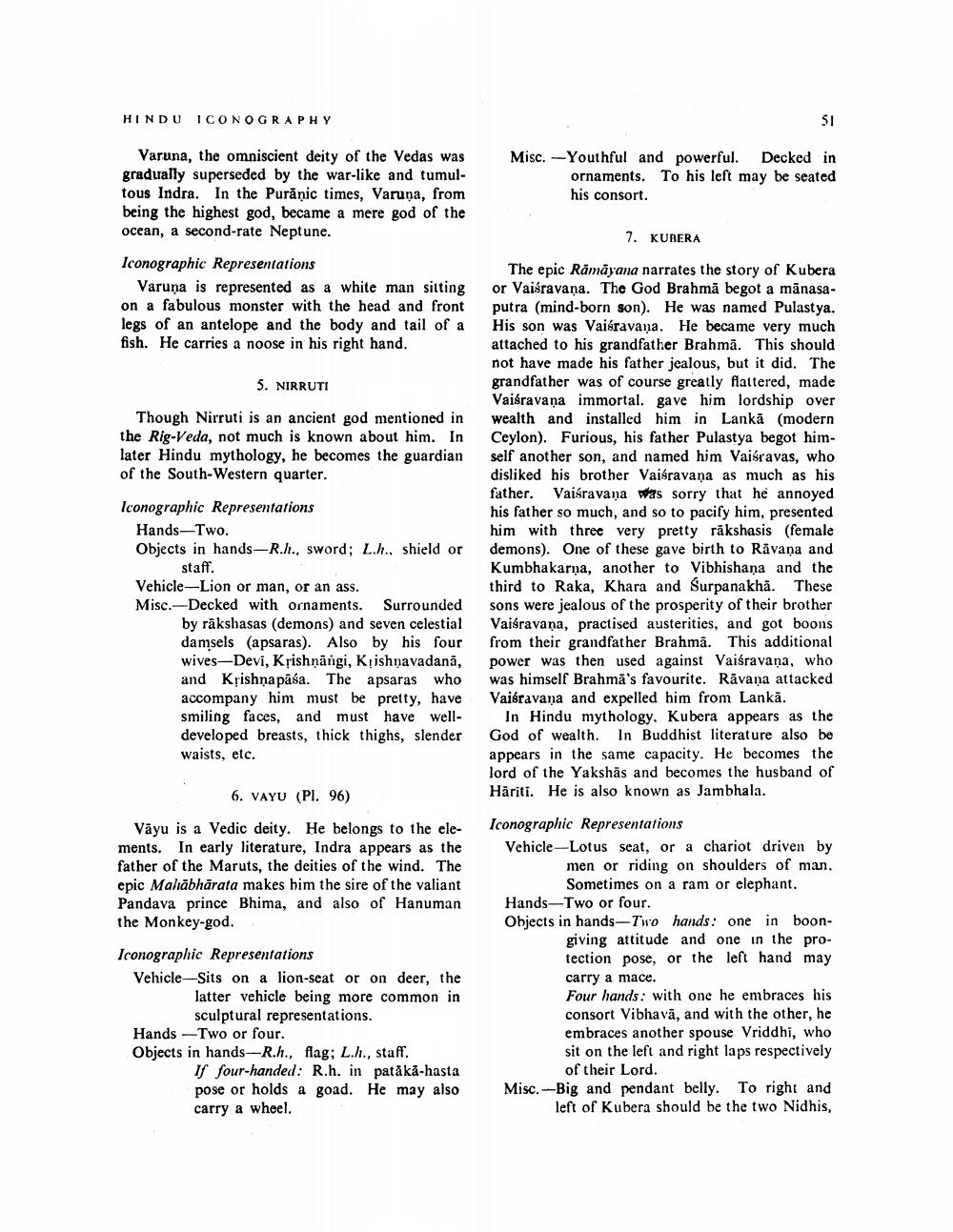________________
HINDU ICONOGRAPHY
Varuna, the omniscient deity of the Vedas was gradually superseded by the war-like and tumultous Indra. In the Puranic times, Varuna, from being the highest god, became a mere god of the ocean, a second-rate Neptune.
Iconographic Representations
Varuna is represented as a white man sitting on a fabulous monster with the head and front legs of an antelope and the body and tail of a fish. He carries a noose in his right hand.
5. NIRRUTI
Though Nirruti is an ancient god mentioned in the Rig-Veda, not much is known about him. In later Hindu mythology, he becomes the guardian of the South-Western quarter.
Iconographic Representations
Hands-Two.
Objects in hands-R.h., sword; L.h.. shield or staff.
Vehicle Lion or man, or an ass. Misc. Decked with ornaments. Surrounded by rakshasas (demons) and seven celestial damsels (apsaras). Also by his four wives-Devi, Krishnangi, Krishnavadanā, and Krishnapāśa. The apsaras who accompany him must be pretty, have smiling faces, and must have welldeveloped breasts, thick thighs, slender waists, etc.
6. VAYU (Pl. 96)
Vayu is a Vedic deity. He belongs to the elements. In early literature, Indra appears as the father of the Maruts, the deities of the wind. The epic Mahabharata makes him the sire of the valiant Pandava prince Bhima, and also of Hanuman the Monkey-god.
Iconographic Representations
Vehicle Sits on a lion-seat or on deer, the latter vehicle being more common in sculptural representations.
Hands -Two or four.
Objects in hands-R.h., flag; L.h., staff.
If four-handed: R.h. in patākā-hasta pose or holds a goad. He may also carry a wheel.
51
Misc. Youthful and powerful. Decked in ornaments. To his left may be seated his consort.
7. KUBERA
The epic Rāmāyana narrates the story of Kubera or Vaisravana. The God Brahma begot a mānasaputra (mind-born son). He was named Pulastya. His son was Vaisravana. He became very much attached to his grandfather Brahma. This should not have made his father jealous, but it did. The grandfather was of course greatly flattered, made Vaisravana immortal. gave him lordship over wealth and installed him in Lanka (modern Ceylon). Furious, his father Pulastya begot himself another son, and named him Vaisravas, who disliked his brother Vaisravana as much as his father. Vaisravana was sorry that he annoyed his father so much, and so to pacify him, presented him with three very pretty rakshasis (female demons). One of these gave birth to Rāvana and Kumbhakarna, another to Vibhishana and the third to Raka, Khara and Surpanakha. These sons were jealous of the prosperity of their brother Vaisravana, practised austerities, and got boons from their grandfather Brahma. This additional power was then used against Vaisravana, who was himself Brahma's favourite. Rāvana attacked Vaisravana and expelled him from Lanka.
In Hindu mythology, Kubera appears as the God of wealth. In Buddhist literature also be appears in the same capacity. He becomes the lord of the Yakshãs and becomes the husband of Hariti. He is also known as Jambhala.
Iconographic Representations
Vehicle Lotus seat, or a chariot driven by men or riding on shoulders of man. Sometimes on a ram or elephant. Hands-Two or four.
Objects in hands-Two hands: one in boongiving attitude and one in the protection pose, or the left hand may carry a mace.
Four hands: with one he embraces his consort Vibhava, and with the other, he embraces another spouse Vriddhi, who sit on the left and right laps respectively of their Lord.
Misc. -Big and pendant belly. To right and left of Kubera should be the two Nidhis,




